Article Information
- ZongXing Li, Qi Feng, YaMin Wang, JianGuo Li, XiaoYan Guo, YongGe Li . 2016.
- Effect of sub-cloud evaporation on the δ18O of precipitation in Qilian Mountains and Hexi Corridor, China
- Sciences in Cold and Arid Regions, 8(5): 378-387
- http://dx.doi.org/10.3724/SP.J.1226.2016.00378
Article History
- Received: April 18, 2016
- Accepted: June 17, 2016
2. Changsha Normal University, Changsha, Hunan 410100, China
It is now well established that the evolution of stable isotope compositions in precipitation can be defined by a Rayleigh-type fractionation equation whenever an isolated moist air mass leaves its oceanic moisture source region and travels toward continental or higher-latitude regions (Craig and Gordon, 1965; Gat and Matsui, 1991; Gat et al., 1994; Peng et al., 2007; Froehlich et al., 2008; Liu et al., 2008; Peng et al., 2010). Although Rayleigh fractionation describes many aspects of the evolution of isotopic compositions in precipitation at the cloud base, it does not always adequately explain the variations of δD and δ18O values in precipitation collected at ground stations (Araguas-Araguas et al., 2000; Gat, 2000; Pang et al., 2011; Kong et al., 2013). For instance, that model does not account for the effect of sub-cloud evaporation, which refers to the evaporation process for raindrops that fall from the cloud base to the ground. Light isotopes are preferentially depleted and heavy isotopes are enriched during the evaporation in the precipitation process (Dansgaard, 1964; Froehlich et al., 2008). The raindrops experiencing sub-cloud evaporation usually show an enrichment of δ18O values (Liu et al., 2008). Additionally, the kinetic isotope effect during sub-cloud evaporation has been posited to cause a decrease in the slope of the δD-δ18O correlation in precipitation (Dansgaard, 1964; Stewart, 1975). Precipitation, temperature, and relative humidity are the main factors affecting sub-cloud evaporation (Peng et al., 2007; Liu et al., 2008; Meng and Liu, 2010), and a longer duration of falling raindrops may also cause more mass evaporation(Stewart, 1975). Thus, the sub-cloud evaporation effect must be considered in such studies using isotopic approaches.
Many previous researches have confirmed the influence from sub-cloud evaporation on isotopic fractionation in precipitation. Correlations of isotopic data with parameters such as local temperature, relative humidity, and precipitation provided evidence that small-amount precipitation undergoes sub-cloud evaporation accompanied by mass-dependent isotope fractionation during its descent from the cloud base to the ground (Peng et al., 2007). Froehlich et al. (2008) and Kong et al. (2013) found that sub-cloud evaporation is governed by the saturation deficit and the distance between the cloud base and the ground, and its effect on the deuterium excess is thought to be lower at mountain stations than at low land/valley stations. Ma et al. (2014) showed that sub-cloud evaporation had a significant effect on stable isotopes when the rainfall amount was small, but the correlation was not significant for snowfall or heavy rainfall, and the sub-cloud evaporation was enhanced as the temperature increased. That study also found that the high δ18O of precipitation over northwestern China is due to evaporative enrichment of δ18O as raindrops fall through dry air, as verified by satellite measurements and climate model simulations (Lee et al., 2012). According to the water vapor δD data retrieved from Scanning Imaging Absorption Spectrometer for Atmospheric Chartography (SCIAMACHY) observations, Liu et al. (2014) suggested that the partial evaporation of falling raindrops is a key driver of water vapor isotopes in arid regions over China. However, there are few studies that quantitatively evaluate the effects of sub-cloud evaporation on the δ18O composition of precipitation.
The extent of the sub-cloud evaporation effect on isotopic fractionation can be evaluated by the δ18O difference between a cloud base and the ground (Froehlich et al., 2008). At present, great efforts are being devoted to exploring the climatological and hydrologic signals of meteoric waters in arid regions of China with the aid of stable isotope studies (Tian et al., 2001; Pang et al., 2011; Yang et al., 2011; Ma et al., 2012; Kong et al., 2013; Guo et al., 2014; Li et al., 2014; Cui and Li, 2015; Li et al., 2015a, b, c, d). However, quantitative evaluation of the effect of sub-cloud evaporation on the stable isotope composition, and the internal mechanisms between them (especially meteorological forcing in arid regions) still lacks adequate investigation. Furthermore, δ18O is more sensitive to sub-cloud evaporation than is δD, and the enrichment degree is related to the sub-cloud evaporation intensity (Froehlich et al., 2008).
Therefore, based on 461 event-based precipitation samples collected from 12 stations in the Qilian Mountains and the Hexi Corridor from May to August of 2013, this study had these two aims: (1) to calculate the evaporation rate of falling raindrops under sub-cloud evaporation; and (2) to evaluate the effects from sub-cloud evaporation on the δ18O composition.
2 Sampling and methods 2.1 Study regionThe Qilian Mountains and the Hexi Corridor (92°E–107°E, 36°N–43°N), with an area of 31.55×104 km2, lie in northwestern China and include three inland river basins; from east to west they are the Shiyanghe River, the Heihe River, and the Shulehe River (Figure 1). The Qilian Mountains, which are located in the northeastern edge of the Qinghai-Tibet Plateau in China, consist of several parallel mountain ranges and valleys, stretching 850 km from northwest to southeast in length and extending 200~300 km in width from south to north. The altitudes of about 30% of the peaks are above 4, 000 m a.s.l., the highest of which is Tuanjie Peak with an altitude of 5, 826.8 m a.s.l. The temperature varies with altitude. The annual precipitation decreases from east to west and from south to north, varying from 400 to 700 mm. The Qilian Mountains are very important to the Hexi Corridor because they are the water sources (precipitation and meltwater) for the Shiyanghe, Heihe, and Shulehe rivers.
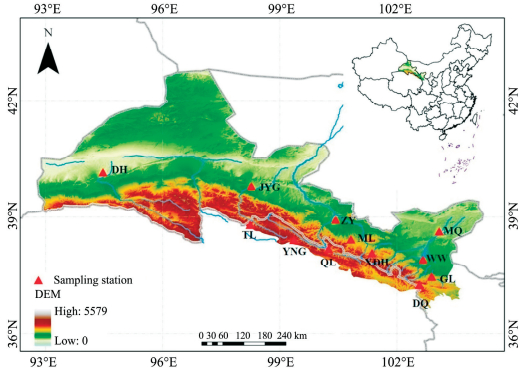
|
| Figure 1 Study region and sampling stations |
The Hexi Corridor is located at the western end of Wushaoling Mountain. It covers an area of 271, 100 km2and includes five cities. It crosses an arid to semi-arid part of China with an annual mean precipitation of 50~200 mm, with precipitation decreasing from east to west. The five main cities in the Hexi Corridor are situated within inland river basins with an annual mean runoff that totals 1.6 billion m3 in the Shiyanghe River, 3.2 billion m3 in the Heihe River, and 1.72 billion m3 in the Shulehe River.
The study region spans three climatic zones from north to south. In the northernmost, near the edges of the Tengger Desert, the Badain Jaran Desert, and the Kumtag Desert, the annual rainfall is about 50 mm and pan evaporation is 2, 000~2, 600 mm/a. The Minqin and Dunhuang stations are in this region. The middle arid zone in the flatland of the Hexi Corridor (altitude 1, 500~2, 000 m a.s.l.) has an annual precipitation of 150~300 mm, and the Wuwei, Zhangye, and Jiayuguan stations are over there. The other seven stations are in the southern cold semi-arid to semi-humid zone of the Qilian Mountains (altitude 2, 000~5, 000 m a.s.l.), which has an annual precipitation of 300~600 mm. With an obvious seasonal variation, about 85% of the total rainfall occurs from May to August. Vegetation is mainly distributed in the mountainous region at the altitude of 2, 000~3, 600 m a.s.l. in the region, and includes alpine meadow belt, alpine grassland belt, alpine forest belt, and alpine farmland.
2.2 Sampling and laboratory analysisAt the precipitation event scale, rainfall samples were collected at five stations (Daiqian, Xidahe, Qilian, Yeniugou, and Tuole) in the high altitudes of the Qilian Mountains, two stations (Gulang and Minle) in the lower altitudes of the Qilian Mountains, three stations (Wuwei, Zhangye, and Jiayuguan) in the Hexi Corridor, and two stations (Minqin and Dunhuang) in the desert region (Table 1). Except for Daiqian and Xidahe, all of the stations are national meteorology observation stations (Figure 1). The sample collectors were placed on the rooftops (8 m above the ground and 1 m above the roof), away from any pollutant sources. Sampling was done manually by wet collectors, which were fitted with a 5-L polyethylene collecting flask (at the bottom) and a polyethylene funnel 26-cm in diameter. The collected rainwater was transferred into precleaned polyethylene sample bottles after each rainfall event. Before installation of the collectors, the funnels and flasks were carefully cleaned and dried. In addition, stringent sampling protocols were followed at all times during sample collection and handling, to assure that samples were not contaminated at the 0.1 meq/L level. In order to avoid possible contamination, precautions were taken in both collection and analysis of the rainfall samples.
| Sampling sites | Latitude (°N) | Longitude (°E) | Altitude (m a.s.l.) | Precipitation events from May to August, 2013 |
| Daiqian (DQ) | 37.26 | 102.58 | 3, 300 | 68 |
| Xidahe (XDH) | 38.08 | 101.36 | 2, 897 | 43 |
| Qilian (QL) | 38.18 | 100.25 | 2, 787 | 57 |
| Yeniugou (YNG) | 38.42 | 99.36 | 3, 320 | 56 |
| Tuole (TL) | 38.80 | 98.24 | 3, 367 | 44 |
| Gulang (GL) | 37.47 | 102.89 | 2, 085 | 45 |
| Minle (ML) | 38.43 | 100.82 | 2, 040 | 36 |
| Wuwei (WW) | 37.92 | 102.67 | 1, 532 | 41 |
| Zhangye (ZY) | 38.93 | 100.43 | 1, 483 | 18 |
| Jiayuguan (JYG) | 39.80 | 98.27 | 1, 658 | 21 |
| Minqin (MQ) | 38.63 | 103.08 | 1, 368 | 13 |
| Dunhuang (DH) | 40.15 | 94.47 | 1, 139 | 19 |
A total of 461 event-based rainfall samples were collected in the study region from May to August of 2013. After collection, all of the samples were immediately sealed in plastic bags and stored at 4 ℃ in a refrigerator without evaporation. During sample collection, the precipitation amount and the temperature, wind speed, and relative humidity were recorded at the corresponding automatic meteorological stations in Daiqian and Xidahe, and other meteorological data were collected from 10 national meteorology observation stations. The precipitation and precipitation samples were analyzed for δ18O by means of laser absorption spectroscopy (DEL-100, Los Gatos Research, Inc., San Jose, CA, USA) (http://www.lgrinc.com) at the Key Laboratory of Ecohydrology of Inland River Basin, Chinese Academy of Sciences. Measurement precision for δ18O was > 0.2‰. The results are reported relative to the Vienna Standard Mean Ocean Water (VSMOW) standard.
2.3 Calculation of δ18O of the cloud base precipitationSub-cloud evaporation increases the δ18O of precipitation, whereas moisture recycling decreases the values of this parameter (Pang et al., 2011; Kong et al., 2013). Therefore, it is necessary to correct the measured δ18O in precipitation under the effect of sub-cloud evaporation. The δ18O of precipitation in the cloud base can be determined by (Froehlich et al., 2008; Kong et al., 2013):
| $^iF{\rm{ = (1}} - \frac{{^{\rm{i}}\gamma }}{{^{\rm{i}}\alpha }}{\rm{)(}}{f^{{\rm{i}}\beta }} - {\rm{1)}}$ | (1) |
where i is 18 (18O) and the equilibrium fraction factor for δ18O is α, which can be dominated by the condensation temperature (Majoube, 1971) and can be calculated by:
| ${10^3}\ln {\alpha ^{18}}{O_W}_{ - V} = {\rm{ }}1.137\left({{{10}^6}/{T^2}} \right){\rm{ }} - {\rm{ }}0.4156\left({{{10}^3}/T} \right) - 2.0667$ | (2) |
where T is the average temperature. The β and γ are estimated by:
| ${\beta ^{\rm{i}}} = \frac{{1 - {\alpha ^{\rm{i}}}{{(D/D')}^n}(1 - h)}}{{{\alpha ^{\rm{i}}}{{(D/D')}^n}(1 - h)}}$ | (3) |
| ${\gamma ^{\rm{i}}} = \frac{{{\alpha ^{\rm{i}}}h}}{{1 - {\alpha ^{\rm{i}}}{{(D/D')}^n}(1 - h)}}$ | (4) |
where the parameter h is the relative humidity, D' and D are the respective diffusion constants of1H2H16O (1H1H18O) and1H1H16O in air, and the ratio D/D' is 1.024/1.0289 (Stewart, 1975). The evaporation rate (f) of falling raindrops can be calculated by (Kinzer and Gunn, 1951):
| $f = 4{\rm{\pi }}aD(1 + \frac{{Fa}}{{s'}})({\rho _a} - {\rho _b})$ | (5) |
where s' represents the effective thickness of a shell around the raindrop, a is the radius of falling raindrops, ρa and ρbare density at the surface of the falling raindrop and in the ambient air, respectively, and F is a dimensionless quantity that measures the actual heat of moisture exchange. The part of the equation D(ρa-ρb) can be dominated by humidity and temperature, and the part of the equation
| $\nu {\rm{ = 9}}{\rm{.58\{ 1}} - {\rm{exp[}} - {{\rm{(}}\frac{r}{{{\rm{0}}{\rm{.885}}}}{\rm{)}}^{{\rm{1}}{\rm{.147}}}}{\rm{]\} }}$ | (6) |
where r is the raindrop radius. Assuming that precipitation forms close to the average cloud-base level (corresponding to 850 hPa), the falling time of the raindrop would be estimated. Based on meteorological data, the effect of sub-cloud evaporation can then be determined.
The relative effect of sub-cloud evaporation on the composition of δ18O can be defined as the sub-cloud evaporation enrichment rate of δ18O (E), which can be estimated by:
| $E = {(^{18}}{\rm{F}} - {{\rm{\delta }}^{18}}{\rm{O}})/{{\rm{\delta }}^{18}}{\rm{O}}$ | (7) |
where 18F is the composition of δ18O in precipitation of the cloud base, and δ18O is the stable oxygen composition in precipitation at the ground sampling stations.
3 Results 3.1 The effects of sub-cloud evaporationWe found that the composition of stable isotopes was mainly controlled by the condensation temperature during the precipitation process. With temperature increase, data above the freezing point showed a gradual increasing trend for the δ18O value, whereas the slope and intercept of the δD-δ18O correlation equation exhibited decreasing trends (Table 2). The δ18O value changed from -15.13‰ (when 0 < T≤5 ℃) to -0.62‰ (when T > 20 ℃). The corresponding slope decreased from 8.23 to 6.78 and the intercept decreased from 17.19‰ to 2.55‰. This indicated that sub-cloud evaporation had an obvious effect on the δ18O values in the study region, except when the temperature was less than 0 ℃ (snow events). The smaller slope and intercept reflected more-intense evaporation during raindrop falling, which showed that evaporation gradually strengthened as the temperature increased. However, sub-cloud evaporation had no obvious effect on precipitation events when the temperature was below 0 ℃ (Table 2). It is obvious that the δ18O value displayed a decreasing trend, whereas the slope and intercept of the δD-δ18O correlation equation had increasing trends with precipitation increase (Table 2). Under heavier or continuous rainfall events, atmospheric water vapor content is saturated and relative humidity increases gradually, so the sub-cloud evaporation would be weakened. Thus, this study demonstrates that sub-cloud evaporation had an obvious effect on small-amount precipitation events during the transition from the cloud base to the ground, and this effect would decline with precipitation increase.
| Average value of δ18O (‰) | δD-δ18O | |||
| Slope | Intercept (‰) | R2 | ||
| Temperature (℃) | ||||
| All | -4.48 | 7.22 | 9.42 | 0.89 |
| T≤0 | -15.13 | 8.23 | 17.19 | 0.96 |
| 0 < T≤5 | -8.68 | 7.6 | 12.77 | 0.93 |
| 5 < T≤10 | -5.65 | 7.42 | 13.67 | 0.91 |
| 10 < T≤15 | -3.76 | 7.55 | 12.02 | 0.84 |
| 15 < T≤20 | -2.81 | 7.45 | 5.81 | 0.85 |
| 20 < T | -0.62 | 6.78 | 2.55 | 0.88 |
| Precipitation (mm) | ||||
| 0 < P≤1 | -2.8 | 6.3 | 4.32 | 0.79 |
| 1 < P≤2 | -4.43 | 7.28 | 6.66 | 0.88 |
| 2 < P≤5 | -4.62 | 7.27 | 8.82 | 0.92 |
| 5 < P≤15 | -4.92 | 7.74 | 15.44 | 0.94 |
| 15 < P | -4.71 | 7.14 | 10.43 | 0.88 |
| Relative humidity (%) | ||||
| H≤50 | -3.50 | 6.88 | 3.05 | 0.89 |
| 50 < H≤70 | -3.95 | 7.03 | 8.69 | 0.88 |
| 70 < H≤80 | -4.86 | 7.63 | 12.31 | 0.91 |
| 80 < H | -5.15 | 7.83 | 13.6 | 0.92 |
The composition of stable isotopes in precipitation was also influenced by the relative humidity. If the relative humidity was 100%, equilibrium fractionation occurred and the composition of the stable isotopes changed with the Rayleigh-type fractionation equation (Craig and Gordon, 1965). However, the variability of relative humidity, wind speed, and the initial evaporation from sea surfaces often caused regional variation of the stable isotopes (Clark and Fritz, 1997). Generally speaking, δ18O in the remaining rainwater was enriched when the relative humidity decreased due to the non-equilibrium sub-cloud evaporation and the molecular kinetic energy difference in the phase shift. With the decrease of relative humidity, δ18O increased from -5.15‰ (80% < H) to -3.5‰ (H≤50%) in the study region, and furthermore, the corresponding slope and intercept of the δD-δ18O correlation equation decreased from 7.83 to 6.88 and from 13.6‰ to 3.05‰, respectively (Table 2). In the Qilian Mountains and the Hexi Corridor, precipitation is usually concentrated in the summer and autumn with high temperatures, so sub-cloud evaporation can be significantly more influential when the relative humidity is decreased, which would cause an increase of the δ18O value, especially for small-amount precipitation events.
3.2 The evaporation rate of falling rain drops from cloud base to groundBased on the above analysis, this study first evaluated the main effect of sub-cloud evaporation on falling raindrops from cloud base to ground during May–August, which has been defined as the evaporation rate of falling drops (f). The average radius of water raindrops is 0.40 mm in the Qilian Mountains and the Hexi Corridor (Kong et al., 2013). Therefore, the effect of sub-cloud evaporation on falling raindrops was estimated with Equations (5) and (6), and the relevant meteorological parameters. In the study region, the average evaporation rates of falling raindrops from cloud base to ground were 19%, 13%, 16%, and 18% in May, June, July, and August, respectively. Also, evaporation showed an obvious decreasing trend from northwest to southeast in the study region, and the lower values were mainly distributed in the Qilian Mountains; the higher values were in the Hexi Corridor, especially in the desert region (Figure 2).
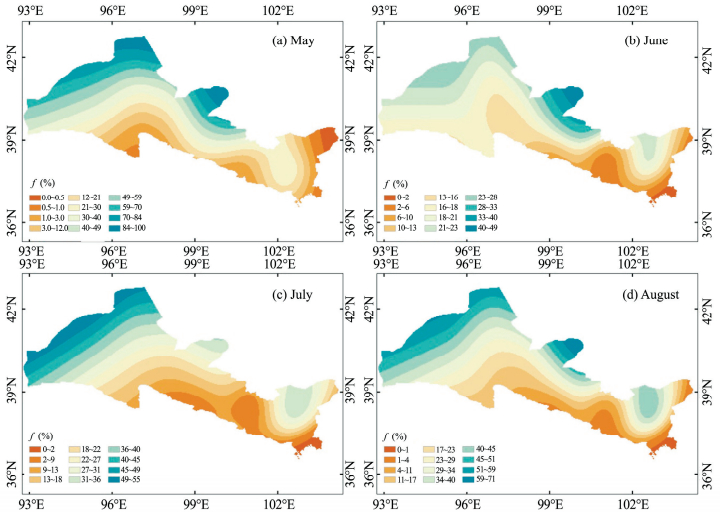
|
| Figure 2 Spatial pattern of the evaporation rates of falling drops from cloud base to ground in May (a), June (b), July (c), and August (d) |
This was further supported by the different evaporation values at different landforms. In the higher altitudes in the Qilian Mountains (including the DQ, XDH, QL, YNG, and TL stations), the average evaporation rates of falling raindrops were 11%, 9%, 9%, and 7% in May, June, July, and August, respectively, while the corresponding values in the lower altitudes of the Qilian Mountains (including the GL and ML stations) were 12%, 8%, 9%, and 9% in May, June, July, and August, respectively. In the Hexi Corridor (including the WW, ZY, and JYG stations), the average evaporation rates of falling raindrops were 27%, 19%, 20%, and 28% in May, June, July, and August, respectively. The maximum evaporation occurred in the desert region (including the MQ and DH stations), where the values were 47%, 20%, 37%, and 39% in May, June, July, and August, respectively. There was also obvious seasonal variation, with a relatively high value in May which then increased from June to August (Figure 3).
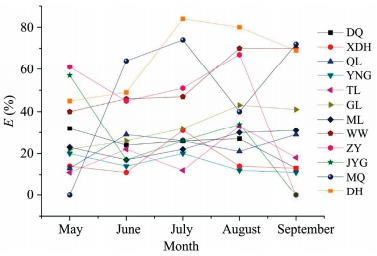
|
| Figure 3 Seasonal variation of the evaporation rates of falling drops at 12 sampling stations |
The evaporation rate of falling raindrops is a reflection of the relative humidity and temperature: low temperature and high relative humidity in the Qilian Mountains result in a lower evaporation rate than in the Hexi Corridor. This can also be clearly seen in the daily variation at the DQ station: on May 21 the relative humidity was 47% and the temperature was 5.07 ℃, but these values changed to 72.4% and 5.5 ℃ on August 28, leading to a significant difference in the evaporation rate: 17% in May and 8% in August. This phenomenon was common at other stations in the study region. Low relative humidity and high temperature will generate strong sub-cloud evaporation, which was very common at the stations in the Hexi Corridor. This can further support the theory that snow samples have small or negligible sub-cloud evaporation from October to April of the following year because the relative humidity is permanently above 70% at mountain stations and the temperature remains below 0 ℃ (Pang et al., 2011).
3.3 The sub-cloud evaporation enrichment rate of δ18O (E)With Equations (1)–(7) and the relevant meteorological parameters, the effect of sub-cloud evaporation on the δ18O composition of precipitation was estimated for the months with temperatures above 0 ℃ (from May to August in the Qilian Mountains and the Hexi Corridor). This can be defined as the sub-cloud evaporation enrichment rate of δ18O (E). Based on our calculations, the δ18O values of precipitation in the cloud base were -7.74‰, -5.34‰, -5.24‰, and -4.80‰ in May, June, July, and August, respectively, and the corresponding values at the ground were -5.0‰, -3.95‰, -3.20‰, and -2.84‰ in the Qilian Mountains and the Hexi Corridor. The average sub-cloud evaporation enrichment rates of δ18O (E) were 35%, 26%, 39%, and 41% in May, June, July, and August, respectively. The E values showed an obvious increasing trend from the Qilian Mountains to the Hexi Corridor (Figure 4), while it decreased from the northwest to the southeast. This was also indicated by the different values in different landforms: In the higher altitudes of the Qilian Mountains (including the DQ, XDH, QL, YNG, and TL stations), the average sub-cloud evaporation enrichment rates of δ18O (E) were 19%, 20%, 23% and 21% in May, June, July, and August, respectively, and the corresponding values in the lower altitudes of the Qilian Mountains (including GL and ML) were 23%, 22%, 27%, and 37% in those months. In the Hexi Corridor (including WW, ZY, and JYG stations), the average sub-cloud evaporation enrichment rates of δ18O (E) were 53%, 36%, 41%, and 57% in those months. The maximums occurred in the desert region (including the MQ and DH stations), which had values of 45%, 56%, 79%, and 60% in those months. As for seasonal variation, the E increased from May to August (Figure 5) and the seasonal fluctuation was more obvious in the Hexi Corridor than in the Qilian Mountains.
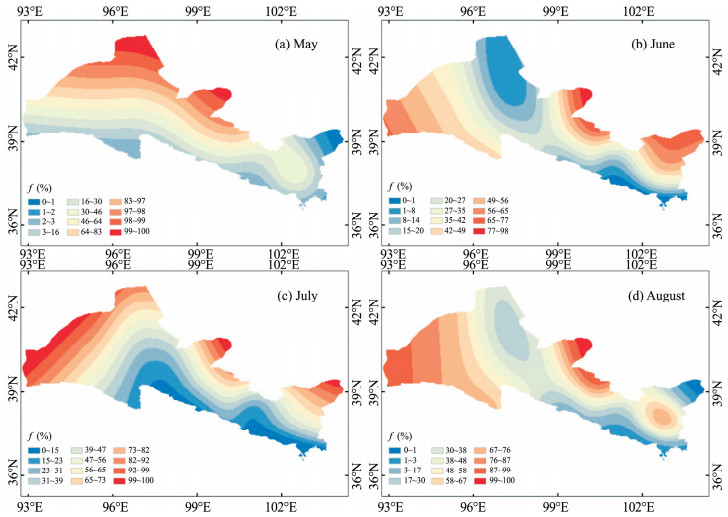
|
| Figure 4 Spatial pattern of the relative influence of sub-cloud evaporation on the δ18O composition of precipitation in May (a), June (b), July (c), and August (d) |
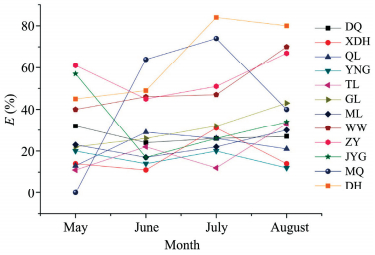
|
| Figure 5 Seasonal variation of the relative influence of sub-cloud evaporation on the δ18O composition of precipitation at 12 sampling stations |
As mentioned above, f and E showed the same patterns of spatial and temporal variation, which reflected the significant relationship between them. This can be also proved by the statistical positive correlations between E and f in the higher and lower altitudes of the Qilian Mountains, the Hexi Corridor, and the desert region (Figure 6); the correlation coefficients were relatively larger in the Hexi Corridor than in the Qilian Mountains. This reflected that fact that the higher the f is, the higher the E is (more enrichment), which also confirmed the great influence of sub-cloud evaporation on the δ18O composition. Figure 6 suggests that the enrichment in the δ18O composition changed with an evaporated fraction of falling raindrops. It should be noted that the δ18O composition would be enriched by 1.1%, 1.3%, 2.1%, and 3.1% when the raindrops are evaporated by 1.0% at the higher and lower altitudes of the Qilian Mountains, the Hexi Corridor, and the desert region, respectively (Figure 6). This also confirms the stronger sub-cloud evaporation in arid climate regions.
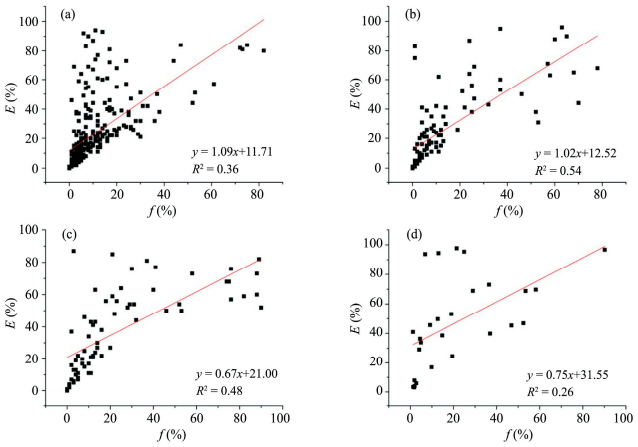
|
| Figure 6 Correlation coefficients between f and E in higher (a) and lower (b) altitudes of the Qilian Mountains, the Hexi Corridor (c), and the desert regions (d) |
Variations in the isotopic composition of precipitation are determined by fractionation processes which occur during temperature-and humidity-dependent phase changes associated with evaporation and condensation. A previous study by Li et al. (2015a) demonstrated that sub-cloud evaporation has no effect on the δ18O value when the temperature is below 0 ℃ in the Qilian Mountains and the Hexi Corridor. Therefore, our correlation analysis between E and various meteorological factors only discussed these precipitation events when the temperature was above 0 ℃ (Table 3); the temperature had a significant positive correlation with E, while the correlation coefficients showed a decreasing trend from the Qilian Mountains to the Hexi Corridor and the desert regions, which confirmed that the influence from temperature was relatively stronger in the Qilian Mountains. Precipitation exhibited a negative correlation with E in the study region, but the significance level was comparatively lower in the Qilian Mountains than in the Hexi Corridor. The correlation coefficients displayed an increasing trend from higher altitudes to lower altitudes, which confirmed the comparatively stronger influence from precipitation in the Hexi Corridor (Table 3). The relative humidity also displayed a negative correlation with E, and the correlation coefficients also had an increasing trend from higher altitudes to lower altitudes, which also reflected the larger influence from relative humidity in the Hexi Corridor (Table 3). As showing in Table 3, the correlation coefficient for temperature was the highest, followed by relative humidity and precipitation in the Qilian Mountains, whereas in the Hexi Corridor the highest correlation coefficient was for relative humidity followed by precipitation and temperature. These characteristics reflected the different dominating factors on E in the different climate regions.
| Location | Temperature | Precipitation | Relative humidity | |
| High altitude of Qilian Mountains | E | 0.45 | −0.46 | −0.50 |
| Lower altitude of Qilian Mountains | E | 0.40 | −0.57 | −0.57 |
| Midstream region | E | 0.20 | −0.50 | −0.57 |
| Downstream region | E | 0.21 | −0.56 | −0.63 |
| aValues for trends significant at the 5% level are set in bold. | ||||
Based on 461 event-based precipitation samples collected from 12 stations in the Qilian Mountains and the Hexi Corridor from May to August of 2013, the effect of sub-cloud evaporation on falling raindrops has been estimated for the months with temperatures above 0 ℃. The raindrops were evaporated by 19%, 13%, 16%, and 18% from the cloud base to the ground in May, June, July, and August, respectively. The spatial pattern showed an obvious decreasing trend from northwest to southeast in the study region, as the lower evaporation values were distributed in the Qilian Mountains while the higher values were in the Hexi Corridor. We also estimated the effect of sub-cloud evaporation on the δ18O composition of precipitation; the sub-cloud evaporation enrichment rates of δ18O were 35%, 26%, 39%, and 41% in May, June, July, and August, respectively, and showed an obvious increasing trend from the Qilian Mountains to the Hexi Corridor. Significant positive correlations between E and f indicated that the higher the f is, the higher the E is (more enrichment). The δ18O composition would be enriched by 1.1%, 1.3%, 2.1%, and 3.1% when the raindrops are evaporated by 1.0% in the higher altitudes and lower altitudes of the Qilian Mountains, the Hexi Corridor, and the desert region, respectively. According to our correlation analysis, the influence of temperature on the sub-cloud evaporation enrichment rate of δ18O was comparatively strong in the Qilian Mountains, whereas relative humidity made a greater contribution to it in the Hexi Corridor. These results provide crucial findings for future study on isotopic hydrology in arid regions.
Acknowledgments:This study was supported by a West Light Program for Talent Cultivation of the Chinese Academy of Sciences, Gansu Province Science Foundation for Distinguished Young Scholars (No. 1506RJDA282), the National Natural Science Foundation (No. 91547102), the CAS/SAFEA International Partnership Program for Creative Research Teams, a postdoctoral fellowship of ZongXing Li in the International Exchange Plans from the China Postdoctoral Association (No. 20140043), and the Youth Innovation Promotion Association, CAS (No. 2013274). Thanks also to the editorial staff.
| Araguas-Araguas L, Froehlich K, Rozanski K, 2000. Deuterium and oxygen-18 isotope composition of precipitation and at-mospheric moisture. Hydrological Process, 14: 1341–1355. doi: 10.1002/1099-1085(20000615) |
| Best AC, 1950. Empirical formulae for the terminal velocity of water drops falling through the atmosphere. Quarterly Journal of Roy Meteorology Society, 76: 302–311. doi: 10.1002/qj.49707632905 |
| Clark I, Fritz P, 1997. Environmental Isotopes in Hydrogeology. New York: Lewis Publishers. |
| Craig H, Gordon LI, 1965. Deuterium and oxygen-18 variations in the ocean and the marine atmosphere. In:Tongiorgi E (ed.). Stable Isotopes in Oceanographic Studies and Paleotempera-tures. Consiglio Nazionaledelle Ricerche, Pisa, Italy, PP. 1-130. Craig H, Gordon LI, 1965. Deuterium and oxygen-18 variations in the ocean and the marine atmosphere. In:Tongiorgi E (ed.). Stable Isotopes in Oceanographic Studies and Paleotempera-tures. Consiglio Nazionaledelle Ricerche, Pisa, Italy, PP. 1-130. |
| Cui BL, Li XY, 2015. Runoff processes in the Qinghai Lake Basin, Northeast Qinghai-Tibet Plateau, China:Insights from stable isotope and hydrochemistry. Quaternary International, 383: 1–10. doi: 10.1016/j.quaint.2015.06.038 |
| Dansgaard W, 1964. Stable isotopes in precipitation. Tellus, 16(4): 436–468. doi: 10.1111/j.2153-3490.1964.tb00181.x |
| Froehlich K, Kralik M, Papesch W, et al, 2008. Deuterium excess in precipitation of Alpine regions-moisture recycling. Isotopes in Environmental and Health Studies, 44: 61–70. doi: 10.1080/10256010801887208 |
| Gat JR, Bowser CJ, Kendall C, 1994. The contribution of evapo-ration from the Great Lakes to the continental atmosphere:es-timate based on stable isotope data. Geophysical Research Letters, 21: 557–560. doi: 10.1029/94GL00069 |
| Gat JR, 2000. Atmospheric water balance-the isotopic perspec-tive. Hydrological Process, 14: 1357–1369. doi: 10.1002/1099-1085(20000615)14:8<1357:AID-HYP986>3.0.CO;2-7 |
| Gat JR, Matsui E, 1991. Atmospheric water balance in the Amazon basin:an isotopic evapotranspiration model. Journal of Geo-physical Research, 96: 13179–13188. doi: 10.1029/91JD00054 |
| Guo XY, Feng Q, Wei YP, et al, 2014. An overview of precipitation isotopes over the Extensive Hexi Region in NW China. Arabian Journal of Geoscience, 8(7): 4365–4378. doi: 10.1007/s12517-014-1521-9 |
| Kinzer GD, Gunn R, 1951. The evaporation, temperature and thermal relaxation-time of freely falling water drops. Journal of Meteorology, 8: 71–83. doi: 10.1175/1520-0469(1951)008<0071:TETATR>2.0.CO;2 |
| Kong YL, Pang ZH, Froehlich K, 2013. Quantifying recycled moisture fraction in precipitation of an arid region using deu-terium excess. Tellus B, 65: 19251. doi: 10.3402/tellusb.v65i0.19251 |
| Lee JE, Risi C, Fung I, et al, 2012. Asian monsoon hydrometeor-ology from TES and SCIAMACHY water vapor isotope measurements and LMDZ simulations:implications for spele-othem climate record interpretation. Journal of Geophysical Research, 117(D15): 156–169. doi: 10.1029/2011JD017133 |
| Li ZX, Feng Q, Guo XY, et al, 2015d. The evolution and environmental significance of glaciochemistry during the ablation period in the north of Tibetan Plateau, China. Quaternary International, 374: 93–109. doi: 10.1016/j.quaint.2014.06.071 |
| Li ZX, Feng Q, Li JG, et al, 2015c. Environmental significance and hydrochemical processes at a cold alpine basin in the Qilian Mountains. Environmental Earth Science, 73(8): 4043–4052. doi: 10.1007/s12665-014-3689-4 |
| Li ZX, Feng Q, Liu W, et al, 2014. Study on the contribution from cryosphere to runoff in the cold alpine basin:A case study of Hulugou River Basin in the Qilian Mountains. Global and Planetary Change, 122: 345–361. doi: 10.1016/j.gloplacha.2014.10.001 |
| Li ZX, Feng Q, Liu W, et al, 2015b. The stable isotope evolution in Shiyi glacier system during the ablation period in the north of Tibetan Plateau, China. Quaternary International,: 262–271. |
| Li ZX, Gao Y, Wang YM, et al, 2015a. Can monsoon moisture arrive Qilian Mountains in summer?. Quaternary International, 358: 113–125. doi: 10.1016/j.quaint.2014.08.046 |
| Liu ZF, Tian LD, Yao TD, et al, 2008. Seasonal deuterium excess in Nagqu precipitation:influence of moisture transport and recycling in the middle of Tibetan Plateau. Environmental Ge-ology, 55: 1501–1506. doi: 10.1007/s12665-012-1820-y |
| Liu ZF, Yoshimura K, Kennedy CD, et al, 2014. Water vapor δD dynamics over China derived from SCIAMACHY satellite measurements. Science China:Earth Sciences, 57(4): 813–823. doi: 10.1007/s11430-013-4687-1 |
| Ma JZ, Zhang P, Zhu GF, 2012. The composition and distribution of chemicals and isotopes in precipitation in the Shiyang River system, northwestern China. Journal of Hydrology,: 92–101. doi: 10.1016/j.jhydrol.2012.02.046 |
| Ma Q, Zhang MJ, Wang SJ, et al, 2014. An investigation of moisture sources and secondary evaporation in Lanzhou, Northwest China. Environmental Earth Sciences, 71(8): 3375–3385. doi: 10.1007/s12665-013-2728-x |
| Majoube M, 1971. Fractionment en oxygene-18 et en deuterium entre l'eau et sa vapeur. Journal of Chemistry Physics, 197: 1423–1436. doi: 10.1007/s12665-012 |
| Meng YC, Liu GD, 2010. Effect of below-cloud secondary evap-oration on the stable isotopes in precipitation over the Yangtze River basin. Advances in Water Sciences, 21: 327–334. doi: 10.12/j.epsl.2010.10.02.(inChinese) |
| Pang ZH, Kong YL, Froehlich K, et al, 2011. Processes affecting isotopes in precipitation of an arid region. Tellus, 63B: 352–359. doi: 10.1111/j.1600-0889.2011.00532.X |
| Peng H, Mayer B, Harris S, et al, 2007. The influence of be-low-cloud secondary effects on the stable isotope composition of hydrogen and oxygen in precipitation at Calgary, Alberta, Canada. Tellus B, 59: 698–704. doi: 10.1111/j.1600-0889.2007.00291.x |
| Peng TR, Wang CH, Huang CC, et al, 2010. Stable isotopic characteristic of Taiwan's precipitation:a case study of western Pacific monsoon region. Earth and Planetary Science Letters, 289: 357–366. doi: 10.1016/j.epsl.2009.11.024 |
| Stewart MK, 1975. Stable isotope fractionation due to evaporation and isotopic exchange of falling water drops:applications to atmospheric processes and evaporation of lakes. Journal of Geophysical Research, 80: 1133–1146. doi: 10.1029/JC080i009p01133 |
| Tian LD, Yao TD, Numaguti A, 2001. Relation between stable isotope in monsoon precipitation in southern Tibetan Plateau and moisture transport history. Science in China (Series D:Earth Sciences), 44(s): 267–273. doi: 10.1016/j.epsl.2001.1.024 |
| Yang YG, Xiao HL, Wei YP, et al, 2011. Hydrologic processes in the different landscape zones of Mafengou River basin in the alpine cold region during the melting period. Journal of Hy-drology, 409: 149–156. doi: 10.1016/j.jhydrol.2011.08.013 |
 2016, 8
2016, 8


